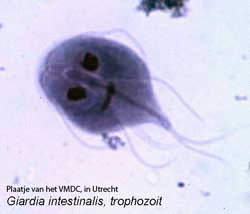The Facts About Canine, Feline and Human Giardiasis
How Do Pets Get Giardiasis?
The most common means of infection is drinking water that is contaminated with Giardia cysts. This may be a lake, a puddle at the dog park, tap water from a well source, or any other source of contaminated water.
Less often, pets can become infected through ingestion of contaminated food, through contact with feces from other dogs or cats that are infected or through contact with contaminated objects.
How Do People Become Infected?
People most often become infected from drinking from a contaminated water source in much the same way that dogs and cats can become infected. Infection can also occur by putting a contaminated object in your mouth or through ingestion of feces from an infected person or animal. Infection by eating contaminated food is also possible.
Protect Your Family and Your Pets from Giardia
There are several things you can do to reduce your risk of becoming infected with Giardia.
• Practice good hygiene by washing your hands thoroughly and frequently. Wash your hands after handling animals. Teach your children to do this also.
• Always wash your hands before handling food and before eating.
• Cook your food thoroughly before eating.
• Be cautious drinking from water sources that may be contaminated. If in doubt, use bottled water for drinking or boil the water before drinking.
• Do not swallow water while swimming.
• Wash all vegetables and fruits thoroughly before eating.
• Do not recycle pet waste for use as fertilizer for gardens and lawns. Do not discard of litter box waste or dog feces in your garden or lawn.
Giardia is a one-celled protozoan parasite that lives in the intestinal tract of many animals. When this parasite produces a diarrheal disease in animals, it is called Giardiasis.
What is Giardia?
Giardia is a one-celled protozoan organism that lives in the intestine of dogs, cats, cows, humans and other animals. Giardia can be found in two forms. The active form is motile (swims around) and is called a trophozoite. The inactive form is called a cyst. The cyst has a “shell” to protect it and can survive outside the body.
Who gets Giardia?
Many animals, including dogs and cats, can be infected with Giardia. The confusing thing is that some animals will test positive for Giardia and have no clinical signs, and some animals with Giardia will be sick. The same is true for humans. Giardiasis is a zoonotic disease. Read more about human Giardia infections from the CDC.
Most often, it is puppies and kittens that will become sick, and animals in crowded situations and under stress are more vulnerable.
What are the signs of Giardiasis?
If signs are seen, the most common one is diarrhea, both for pets and people. Nausea, bloating and cramping may also be noted in humans. The Giardia parasite interferes with the absorption of fats, so the stool is often greasy and with a foul odor.
How is Giardia spread?
This parasite is most commonly spread through infected water sources. The “tougher” cyst form can live for several months in cool wet conditions. Giardia can be found in food, water, feces and anything contaminated with these substances. Transmission is fecal-to-mouth; it is not spread by blood.
How is Giardia diagnosed?
This parasite is difficult to find on fecal examination. Several tests may need to be run over a period of days. Giardiasis is often missed or mis-diagnosed.
A test called the SNAP® Giardia Test by Idexx Laboratories has made diagnosis easier. This test measures Giardia antigen in fecal samples. This is much more accurate than fecal samples alone.
What is the Treatment for Giardia?
This is sometimes a point of debate; should animals (and humans) who test positive but without clinical signs be treated? Treatment is usually recommended for the protection of all family members, especially young children who do not always practice good hygiene.
Metronidazole (Flagyl) is commonly used to treat Giardiasis, but there may be side effects and efficacy is about 70%. Fenbendazole (Panacur) has been shown to have less side effects and possibly be more effective. There are other drugs available for pets and for humans. Please speak to your vet or human physician for the best recommendation for your situation.
Cleaning up after Giardia
Because the Giardia cysts can contaminate and live in the environment so easily, environmental control is a must.
• Start with the patient – a bath will remove any Giardia trophozoites or cysts on the fur. Rinse well. Isolate sick animals in an easily disinfected area.
• Treat and isolate all affected animals.
• Practice good sanitation and personal hygiene to protect yourself and animals. Wash hands with warm soapy water, taking extra care after handling infected animals and feces.
• For kennel spaces and cleanable surfaces (not for use on pets!), a dilute bleach solution (1 part bleach / 10 parts water) will kill Giardia. Leave on a few minutes, rinse well. Be sure to have proper ventilation.
• Giardia do not survive in hot, dry environments. Letting surfaces dry out well will help.
• Boil any drinking water you are unsure about.
• Bathe after using recreational water – lakes, streams, etc.


